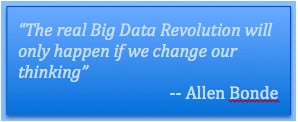There’s huge market and business investment in the Big Idea that is known as Big Data. But missing from the conversation is the key point: how do we convert data – at scale and from multiple sources, into consumer style, simple yet truly smart data-driven apps that deliver value to all types of users in their everyday roles?
That’s the Big Problem and, without addressing it, we simply can’t offer the kind of effective data-driven apps that analysts like IDC see as “the next big thing” in marketing and sales.
These are the kinds of “everyday” apps customers are crying out for: apps that offer useful insights or connect them to essential resources. Apps that may tap massive amounts of data, but present it in highly visual, easy to manipulate interfaces that end-users can use intuitively with zero training. Think about it like this: people want apps that add value
to their lives – professional and personal. They want apps that are personalised for them and their daily tasks. They want highly responsive apps that change as their needs do – apps that, in fact, adapt to location or how they are accessed, whether on a laptop, mobile or even wearable device.
So how do we funnel all that Big Data horsepower into smaller, more bite-sized functionality? It starts by thinking “Small.” More precisely, we need to create new “information hubs” that will filter multi-source Big Data into the meaningful Small Data that will add the kind of value end-users are looking for – and enterprises will need to deliver if they are to become more customer focused.
So the challenge is to deliver this Small Data to our customers – internal and external – via new types of data-driven apps and experiences.
What will those data-driven apps look like? For starters, they’ll incorporate a mix of historical, real time and trend-based data. Real-time data can support daily deal or target selling services for consumers as much as it can support industrial functions like inventory optimisation. Historical or trend data can power competitive intelligence or online
merchandising apps, and so on. A great example is the Kayak when-to-book tool. What makes it special is that it takes literally billions of data points at the back end from pricing and trend information, and transforms this massively Big Data into Small Data via a simple dashboard that provides actionable purchasing guidance (“Buy” or “Wait”).
In fact, there are many compelling information apps we could create by accessing all our Big Data and serving it up as super useful, actionable Small Data. But to get to the full potential of data-driven customer facing apps, we’re going to need effective technology to help us in the collection and processing phase of all that data, as well as tools to compose it and visualise it for easy consumption and decision making.
The good news is that a set of clear principles are starting to emerge that data-driven app designers can take advantage of. These best practice guidelines started to become clear after years of tracking the move from Big Data to practical Small Data, in my time as an analyst and researcher at firms such as Yankee Group, McKinsey, and most recently the Digital Clarity Group, where I and my colleagues defined the notion of Small Data in a marketing context.
Supporting these emerging principles will be better business analytics and superior APIs.
At our company Actuate – working with our 200+ OEMs and millions of BIRT and BIRT iHub developers – we’ve found some clear ways forward:
- Start with the customer – it’s their journey that you are going to streamline, so the apps you build have to useful at each step.
- Think about the ‘last mile’ of Big Data – don’t concentrate all your effort on the macro picture. Think about what your customers – whether internal or external – are going to need and how the right information can be delivered, and work upstream from there.
- Don’t forget scale – you still need to have the horsepower to roll out your new data-driven apps to (potentially) millions of people, on potentially dozens of different types of devices.
- Personal is the new interactive – your data-driven apps need to be customisable by each single user, even if you are rolling them out to many people at once.
In this ongoing wave of change, what is certain is that methods exist to make the power of Big Data practical for everyday tasks – via new, consumer style data-driven apps. Creating the design environments and ecosystem to foster those methods and the developers that will bring them to life can really help you create your next competitive advantage.
 Allen Bonde is VP of Product Marketing & Innovation at Actuate, an advisor to several start-ups, and a former digital media and Internet CMO. An early proponent of self-service apps and data-driven marketing, he has helped global leaders with their big data and customer experience strategies, and shares his perspectives as a contributor to Forbes.com, DM News, and Small Data Group – his top-rated blog. He started his career as a researcher and data scientist in the telecom sector, and was part of teams at McKinsey and Yankee Group that did early work in online advertising and e-commerce. Allen attended Brown University, and holds degrees from the University of Virginia and Worcester Polytechnic Institute.
Allen Bonde is VP of Product Marketing & Innovation at Actuate, an advisor to several start-ups, and a former digital media and Internet CMO. An early proponent of self-service apps and data-driven marketing, he has helped global leaders with their big data and customer experience strategies, and shares his perspectives as a contributor to Forbes.com, DM News, and Small Data Group – his top-rated blog. He started his career as a researcher and data scientist in the telecom sector, and was part of teams at McKinsey and Yankee Group that did early work in online advertising and e-commerce. Allen attended Brown University, and holds degrees from the University of Virginia and Worcester Polytechnic Institute.
Follow Allen on Twitter at @abonde or email him at [email protected]





